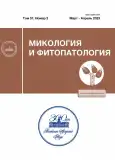New Records of Archaeorhizomycetes from Russia Revealed by Metagenomic Approach
- 作者: Bibikov N.M.1, Voronina E.Y.1, Kurakov A.V.1
-
隶属关系:
- Lomonosov Moscow State University
- 期: 卷 57, 编号 2 (2023)
- 页面: 79-85
- 栏目: БИОРАЗНООБРАЗИЕ, СИСТЕМАТИКА, ЭКОЛОГИЯ
- URL: https://journals.rcsi.science/0026-3648/article/view/138048
- DOI: https://doi.org/10.31857/S0026364823020058
- EDN: https://elibrary.ru/NIEPKA
- ID: 138048
如何引用文章
全文:
详细
The class Archaeorhizomycetes (Taphrinomycotina, Ascomycota) is a cosmopolitan group of fungi associated with the plant root system. Representatives of this class are extremely poorly studied due to the difficulty of cultivation, but sequences belonging to Archaeorhizomycetes are often detected during sequencing of natural substrates. Four unique sequences belonging to Archaeorhizomycetes were obtained during a study of the diversity of fungi associated with the orchid Goodyera repens by next-generation high-throughput sequencing of the ITS2 site. One sequence identical to Archaeorhizomyces borealis was identified in Russia for the first time, while two sequences presumably belong to a yet undescribed genus. One sequence belonging to an undescribed species of the genus Archaeorhizomyces is the most frequently detected in all types of samples (sod-podzolic soil, coniferous tree roots, rhizosphere, and orchid roots). The presence of nucleotide sequences of representatives of this class in the root system of Goodyera repens was shown for the first time, and the presence of one sequence in free soil was shown for the first time. The sequences were deposited in the GenBank database.
作者简介
N. Bibikov
Lomonosov Moscow State University
Email: bibik0808@mail.ru
Russia, 119234, Moscow
E. Voronina
Lomonosov Moscow State University
Email: mvsadnik@list.ru
Russia, 119234, Moscow
A. Kurakov
Lomonosov Moscow State University
编辑信件的主要联系方式.
Email: kurakov57@mail.ru
Russia, 119234, Moscow
参考
- Buscardo E., Rodríguez-Echeverría S., Barrico L. et al. Is the potential for the formation of common mycorrhizal networks influenced by fire frequency? Soil Biol. Biochem. 2012. V. 46. P. 136–144. https://doi.org/10.1016/j.soilbio.2011.12.007
- GenBank. National Center for Biotechnology Information, 2022. https://www.ncbi.nlm.nih.gov/genbank. Accessed 14.10.2022.
- Genre A., Lanfranco L., Perotto S. et al. Unique and common traits in mycorrhizal symbioses. Nat. Rev. Microbiol. 2020. V. 18 (11). P. 649–660. https://doi.org/10.1038/s41579-020-0402-3
- Huang J., Nara K., Zong K. et al. Ectomycorrhizal fungal communities associated with Masson pine (Pinus massoniana) and white oak (Quercus fabri) in a manganese mining region in Hunan Province, China. Fungal Ecol. 2014. V. 9. P. 1–10. https://doi.org/10.1016/j.funeco.2014.01.001
- Kõljalg U., Nilsson H.R., Schigel D. et al. The taxon hypo-thesis paradigm – on the unambiguous detection and communication of taxa. Microorganisms. 2020. V. 8 (12). P. 1910. https://doi.org/10.3390/microorganisms8121910
- Lindahl B.D., Ihrmark K., Boberg J. et al. Spatial separation of litter decomposition and mycorrhizal nitrogen uptake in a boreal forest. New Phytol. 2007. V. 173 (3). P. 611–620. https://doi.org/10.1111/j.1469-8137.2006.01936.x
- Malysheva E.F., Malysheva V.F., Shchepin O.N. et al. Wildfire influence on structure and species composition of ectomycorrhizal fungal communities in pine forests in northwest Russia: the results of metagenomic analysis. Mikologiya i fitopatologiya. 2018. V. 52 (5). P. 328–348. https://doi.org/10.1134/S0026364818050057
- Menkis A., Burokienė D., Gaitnieks T. et al. Occurrence and impact of the root-rot biocontrol agent Phlebiopsis gigantea on soil fungal communities in Picea abies forests of northern Europe. FEMS Microbiol. Ecol. 2012. V. 81 (2). P. 438–445. https://doi.org/10.1111/j.1574-6941.2012.01366.x
- Menkis A., Urbina H., James T.Y. et al. Archaeorhizomyces borealis sp. nov. and a sequence-based classification of related soil fungal species. Fungal Biol. 2014. V. 118 (12). P. 943–955. https://doi.org/10.1016/j.funbio.2014.08.005
- Miyamoto Y., Maximov T.C., Kononov A. et al. Soil propagule banks of ectomycorrhizal fungi associated with Larix cajanderi above the treeline in the Siberian Arctic. Mycoscience. 2022. V. 63 (4). P. 142–148. https://doi.org/10.47371/mycosci.2022.05.002
- Motiejūnaitė J., Kačergius A., Kasparavičius J. et al. Response of ectomycorrhizal and other Pinus sylvestris root-associated fungi to the load of allochthonous material from a great cormorant colony. Mycorrhiza. 2021. V. 31 (4). P. 471–481. https://doi.org/10.1007/s00572-021-01034-5
- Prenafeta Boldú F.X.P., Summerbell R.C., de Boer W. et al. Biodiversity and ecology of soil fungi in a primary succession of a temperate coastal dune system. Nova Hedwigia. 2014. V. 99 (3–4). P. 347–372. https://doi.org/10.1127/0029-5035/2014/0203
- Qin J., Zhang W., Ge Z.W. et al. Molecular identifications uncover diverse fungal symbionts of Pleione (Orchida-ceae). Fungal Ecol. 2019. V. 37. P. 19–29. https://doi.org/10.1016/j.funeco.2018.10.003
- Rosling A., Cox F., Cruz-Martinez K. et al. Archaeorhizomycetes: unearthing an ancient class of ubiquitous soil fungi. Science. 2011. V. 333 (6044). P. 876–879. https://doi.org/10.1126/science.1206958
- Rosling A., Timling I., Taylor D.L. Archaeorhizomycetes: patterns of distribution and abundance in soil. In: B.A. Horwitz, P.K. Mukherjee, M. Mukherjee (eds). Genomics of soil-and plant-associated fungi. Springer, Berlin, Heidelberg, 2013. P. 333–349. https://doi.org/10.1007/978-3-642-39339-6_14
- Schadt C.W., Rosling A. Global diversity and geography of soil fungi. Minus one widespread group. Science. 2015. V. 348 (6242). https://doi.org/10.1126/science.aaa4269
- Suetsugu K., Matsuoka S., Shutoh K. et al. Mycorrhizal communities of two closely related species, Pyrola subaphylla and P. japonica, with contrasting degrees of mycoheterotrophy in a sympatric habitat. Mycorrhiza. 2021. V. 31 (2). P. 219–229. https://doi.org/10.1007/s00572-020-01002-5
- Taylor D.L., Hollingsworth T.N., McFarland J.W. et al. A first comprehensive census of fungi in soil reveals both hyperdiversity and fine-scale niche partitioning. Ecol. Monogr. 2014. V. 84. P. 3–20. https://doi.org/10.1890/12-1693.1
- Uesugi T., Nakano M., Selosse M.A. et al. Pyrola japonica, a partially mycoheterotrophic Ericaceae, has mycorrhizal preference for russulacean fungi in central Japan. Mycorrhiza. 2016. V. 26 (8). P. 819–829. https://doi.org/10.1007/s00572-016-0715-2
- UNITE. 2022. https://unite.ut.ee/index.php. Accessed 14.10.2022.
- Urban A., Puschenreiter M., Strauss J. et al. Diversity and structure of ectomycorrhizal and co-associated fungal communities in a serpentine soil. Mycorrhiza. 2008. V. 18 (6). P. 339–354. https://doi.org/10.1007/s00572-008-0189-y
- Voronina E.Y., Malysheva E.F., Malysheva V.F. et al. A mixo-trophy is in question: new data on fungal community associated with photosynthetic terrestrial orchid Goodyera repens. Botanica Pacifica. 2018. V. 7 (1). P. 51–61. https://doi.org/10.17581/bp.2018.07106
- Zhang X.Y., Tang G.L., Xu X.Y. et al. Insights into deep-sea sediment fungal communities from the East Indian Ocean using targeted environmental sequencing combined with traditional cultivation. PLOS One. 2014. V. 9 (10). P. 109–118. https://doi.org/10.1371/journal.pone.0109118











